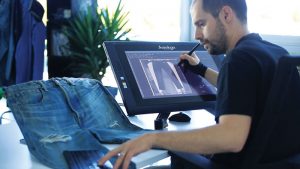
Laser systems for textile finishing and embellishment offer versatile and eco-friendly finishing options
By Dr. Traci A.M. Lamar
At ITMA 2019, most laser finishing system concepts introduced focused on design capability, productivity and a systems approach to sustainability, particularly in denim processing. Lasers also have the capacity to produce an extensive range of finishing effects that would otherwise require application of multiple chemical and mechanical finishing processes using several different pieces of equipment, making these systems versatile and eco-friendly.
Though these lasers for finishing also commonly have cutting capability, they excel in rapid and flexible distressing and embellishing offering fast and precise engraving and marking effects. Particularly suited to laser treatment of textiles are carbon dioxide (CO2) lasers. CO2 lasers use a mixture of gases such as CO2, nitrogen, hydrogen and helium in a mirrored tube. When excited by an electrical current, the gas produces thermal energy which is reflected by the mirrors and intensified producing a beam of laser light from one end of the tube. The laser beam must be directed to the textile surface for laser treatment to occur. To move the laser beam around the material at the speed required to achieve finishing effects, a galvo mechanism is typically used. Galvo systems use motorized, high speed mirrors to direct the laser beam onto the material surface. Because only the motorized mirror is moving during processing, the laser can be directed over the material being treated at very high speeds with great precision. Because the laser head does not physically move, galvo lasers are very fast and efficient systems for distressing and finishing textiles. Such systems are able to cut and enhance single layer fabrics, as well as age and distress products.
At ITMA, systems were shown both for enhancing finished products and for treating fabrics prior to assembly. Finished product treatments, especially jeans, were the predominant focus of demonstrations. Textile laser systems are increasingly important to the denim industry where they can be integral in sustainable production systems for fabrics and products. Laser application in denim finishing is particularly attractive from a production system perspective because lasers can recreate the combined effect of several other chemical and mechanical processes in one single operation.
A Variety Of Capabilities
Aside from variations in laser power, which is expressed in watts, internal capabilities of the laser mechanism itself are quite similar across most textile laser systems. Key differentiators from one textile laser system to the next include the software interface and capabilities, the effectiveness of the system over time, and the required production capacity. At the most recent ITMA, laser finishing concepts introduced focused on design capability, productivity and a systems approach to sustainability particularly in denim processing. One exception to this is VAV Technology, which showcased an innovation related to the laser tube itself. Companies based in Italy, Spain, and Turkey were well represented at ITMA 2019 in the field of laser marking and engraving. A few Chinese firms also were showcasing laser capabilities although the main focus of their exhibits was laser cutting rather than finishing.
Laser Systems From Italy
OT-Las S.r.l. introduced its ReJeans concept at ITMA 2019 emphasizing it as a versatile concept supporting creativity and design flexibility. The concept utilizes its CX-T system, which can laser treat textiles in a continuous or stepwise process and offers flexibility for customized products — an approach that was demonstrated during the show feeding denim into the laser treatment booth from a roll where garment parts were laser treated for finishing effects and cut out for assembly in one combined process. To highlight the creative potential of the ReJeans concept, OT-Las featured products from Italy-based Ideal Blue, a design and manufacturing company that utilizes OT-Las treatment for denim in its ethical manufacturing process. A diverse array of unique products was shown with details including elaborate repeating textile designs, tonal photographic effects, and novel textures achieved using lasers. OT-Las also offers a roll-to-roll laser treatment system for creating continuous effects on roll goods.
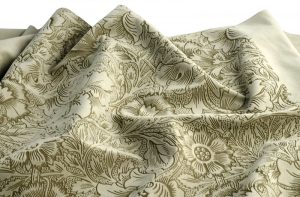
Sei S.p.A., also known as Sei Laser, showcased its Matrix Textile laser system and its potential as a disruptive technology in denim processing. The modular Matrix Textile system can be used for high productivity roll-to-roll and roll-to-garment part processing, allowing manufacturers to mark for assembly, cut garment parts and finish with laser effects in one step. The flexibility provides an opportunity to optimize production flow in manufacturing. The Matrix Textile system targets faster turnaround and production, reducing it to a few days in a well-planned production and finishing system. During ITMA 2019 presentations, Sei Laser highlighted the eco-friendly nature of the laser processing because it uses no water and no chemicals, as well as its ability to optimize fabric utilization and thereby reduce fabric consumption. Of particular interest in terms of material utilization and efficiency, Sei showed how the brand marking, care label, size information, and style number can be directly applied to the inside of the waistband. In addition, the cut parts were labeled for assembly with some instruction. Unlike cutting garment parts with blades that inherently includes some limitations in shape, the Matrix Textile laser has no limitations on cut shapes. The approach advanced by Sei Laser offers an appealing solution for a micro-factory environment where flexibility and versatility are key to an effective production system. The Icaro Textile software developed for the laser can process any vector or raster image specifically for adding the laser surface effects including importing a wide range of image file types. Sei Laser also offers the Flexi Denim system for garment processing.
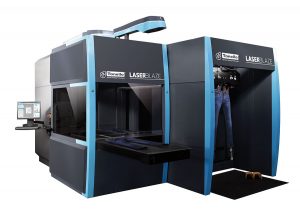
different power options.
Tonello S.r.l. also offers unique design capability in its system with an online shop for laser designs — the first in the world, according to the company — with downloadable options available 24/7 as well as custom laser design service. In addition to the new laser software touted as user-friendly and responsive, Tonello’s mannequin laser systems allow 360° treatment for authentic laser effects mimicking actual wear and crossing seamlines. This approach is in contrast to flat-folded products that are laser treated on a table one side at a time, which does not allow the decorative effects to continue around the garment. Three variations of Tonello’s Laser Blaze are available — T, TM and C — offering a fixed or double sliding table, mannequin, table and mannequin, or conveyor loading. The system includes a design library of laser designs to get new users started.
At ITMA, Tonello featured a flat table Laser Blaze featuring a laser head that could be positioned in either of two locations to support two loading tables side-by-side.
Laser Systems From Spain
Jeanologia S.L. offers lasers in a variety of configurations targeted to differing levels of production from its Flexi Lab flat booth system for prototyping and small-scale production, to the Twin Pro mannequin system that employs two laser heads for simultaneous treatment of both legs of a garment. Jeanologia laser components included a mannequin-type laser that can treat jeans on a form, and a flat-bed-type system capable of handling varied products such as jackets and T-shirts. Jeanologia’s eMark software drives the lasers and offers enhanced design capabilities and tools for novel effects including light scraper, light PP spray and light drill to easily mimic manual and chemical finishing processes. At ITMA, Jeanologia showed its laser equipment as part of a fully conceived finishing system for denim products that also included ozone finishing equipment and a water recycling unit. According to the company, the system can provide a dramatic decrease in water consumption during denim processing, and is connected via digital technology making it flexible and providing the opportunity for a customizable, customer-responsive production system.
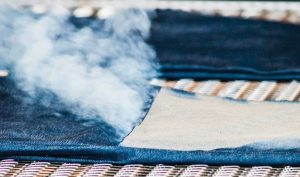
Iberlaser incorporates a variety of productivity features across its laser models reflecting several approaches. One system features two laser heads each with its own belt feed allowing constant operation of the laser and continuous loading of products to be processed. Its most advanced laser system uses only one laser tube that can move, allowing laser treatment on a flat table with two automatic loading belts as well as a mannequin in one unit. Sample products, including jeans and T-shirts, featured all-over repeating textile designs that pushed beyond the most often seen distressing .
Macsa ID S.A. offers three laser system alternatives — a mannequin, a flat system, and a smaller scale laser for customizing products. The mannequin system features side-scrolling loading for continuous loading and processing; the flat table offers double conveyor loading for enhanced productivity; and the third system provides a 30 centimeter (cm) by 30 cm bed for smaller scale product customization. The company reports its technology reduces water and energy use, optimizes denim distressing using no chemicals, and offers productivity of up to 200 pieces per hour. The denim lasering has no effect on fiber strength, but rather only sublimates the indigo dye, according to the company.
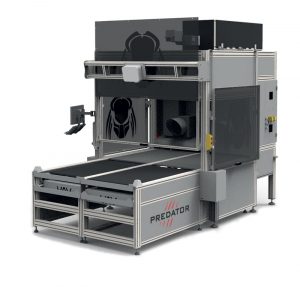
the unique Never-
Ending Power Laser Tube technology.
Other Laser Systems
Germany-based VAV Technology GmbH, with facilities in Turkey, has a comprehensive focus on denim finishing technology. The company has taken a novel approach with the Predator laser machine series included in its finishing line by designing it to run with its NEP — Never-Ending Power Laser Tube. A canister provides the gas mixture needed to produce the laser beam. Consequently, the gas mix in the laser tube on the machine is renewed constantly and never loses its quality. In conventional laser tubes, gas is contained in the laser tube and over time it depletes causing the laser tube to lose power and require replacement. The Predator’s gas replaceable canister not only continuously renews the gas in the laser tube, but can also be easily changed periodically to maintain constant laser power over time. The machine series includes several flat bed systems and a mannequin system. One machine shown at ITMA 2019 featured a system of four sliding tables, arranged in pairs side-by-side, feeding a flat laser. As the laser treatment finished, the table inside the machine dropped and began to slide forward and out of the machine while the loaded table slid above it into the laser booth. The computerized interface allowed the operator to observe what was happening on each of the four tables at any given time, whether a product was processing, waiting, preparing or unloading. VAV Technology includes its laser as a component of its “No Hand Touch” total system of eco-friendly finishing equipment. The company recommends an ozone treatment process to brighten products as needed following laser processing.
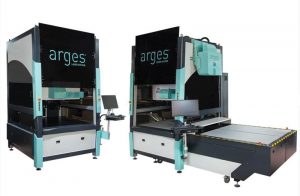
a 3D+ Optical System that can rapidly change an automatically focused beam diameter using specialized software.
The textile laser configurations from Arges Laser System, Turkey, are flat table systems with for enhanced processing speeds. The system offers four moveable tables for loading, unloading, and laser treating continuously with two operators working side-by-side. A projection screen shows the engraving location on each product as it is loaded for treatment. Notable features include its 3D+ Optical System developed for better design transitions, thinner lines and greyscale; and the Arcon software that drives the laser, which is capable of processing a wide range of file types. Arges Laser technology also is eco-friendly and efficient in terms of power utilization and therefore a good fit with sustainable finishing systems. The company also offers an ozone washing system as a complement to the laser in a more sustainable processing system.
Laser Systems From China
At ITMA 2019, Han’s Yueming Laser showed a small scale laser with a bed that can easily adjust to dramatically raise and lower the laser platform. This adjustability allows the focal length of the laser beam — the distance where the beam actually focuses — to engrave with high accuracy and efficiency, and the machine can accommodate materials diverse in thickness and shape. The laser is envisioned for quick and easy embellishments or other customizations on finished products, and its small size allows the laser to be used in a environment such as a shopping center or mall. Though the laser treatment surface is small, the adjustable laser allows the bed to move up and down for significant variation. Customized products on display included a shoe and a volleyball.
CK Laser offers a variety of laser technologies including ones that feature laser engraving ability. The systems range in size and utilize a flat bed rather than a mannequin. They also feature optical placement guides that project onto the loading surface to ensure that operators can properly position the materials before the laser treatment.
Wuhan Golden Laser Co. Ltd. and Gbos Laser Inc. both showcased their laser cutting systems at the last ITMA. Golden Laser does have some laser engraving systems available including machines targeted to the footwear industry and to textile material processing. Among the offerings is a roll to roll engraving machine for textile roll goods. Likewise, Gbos laser has a variety of systems available with capabilities including cutting small pieces for lingerie and engraving for denim. The company highlighted systems that recognized visually what to cut and where. These cutting systems were very small and accurate, for items the size of a garment label. The laser systems recognize color differences and can cut specifically to an outline or a pattern based on the placement of a design on a textile surface.
Sustainable Production
Sustainability in relation to denim production was a notable overall theme at ITMA 2019. One of the greatest advantages of laser finishing for denim and denim products, aside from its sustainability aspects, is the laser’s ability to produce an extensive range of effects that would otherwise require application of multiple chemical and mechanical finishing processes using several different pieces of equipment. This capability makes laser treatment an attractive option for firms targeting customized and small run production, and micro-factory environments where versatility is key. When supported by a robust, design-focused integrated software programs, lasers become a powerful tool in creating innovative products for niche and exclusive markets. Laser firms are starting to explore laser applications to materials beyond denim, including pile fabrics and knit goods. The roll-to-roll machine configurations offered by some laser manufacturers, is poised to impact the production and finishing of textile materials themselves in the future, as well as product categories beyond denim.
Editor’s Note: Dr. Traci A.M. Lamar is an assistant professor in Textile and Apparel Technology and Management at North Carolina State University, Raleigh, N.C.
July/August 2020




